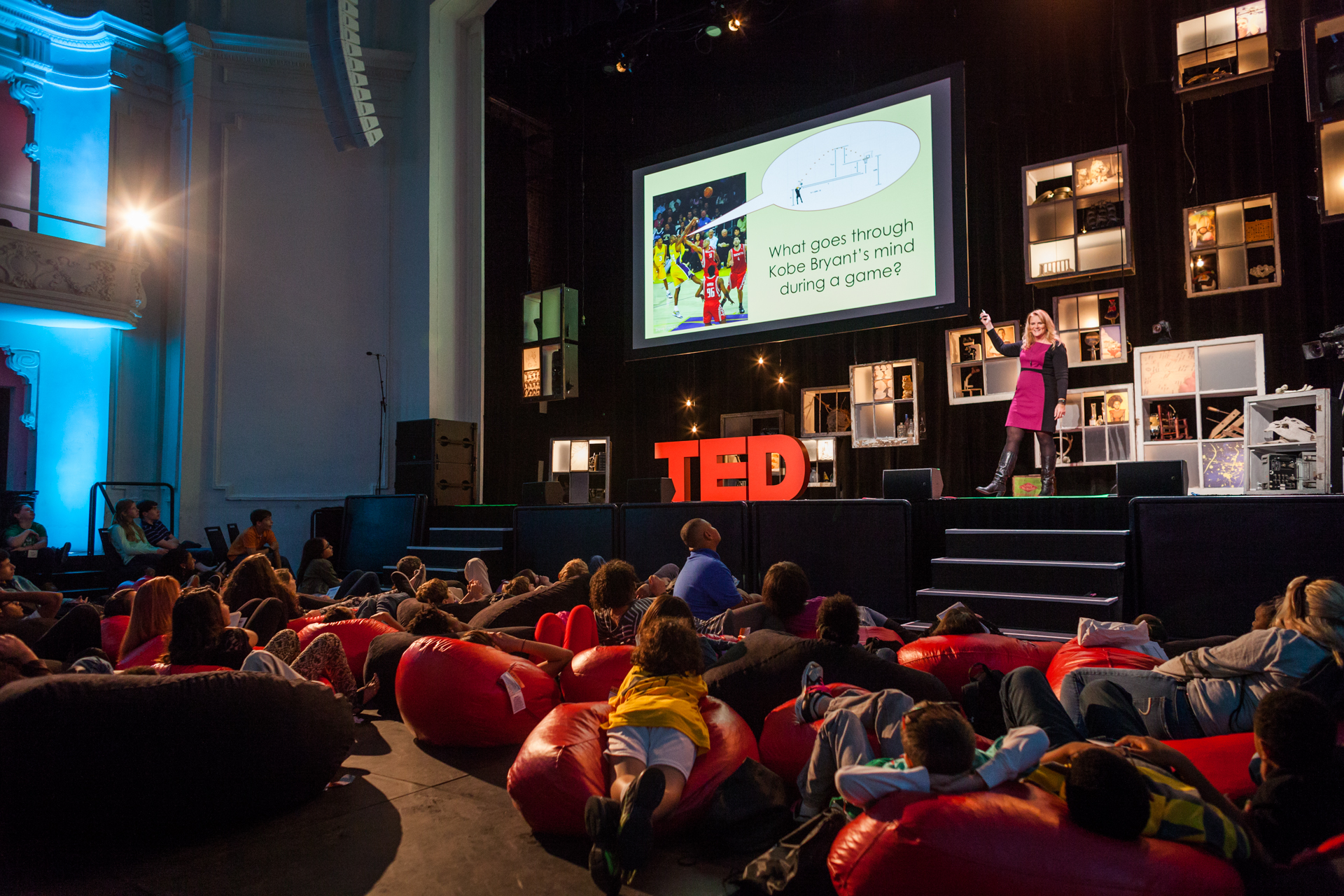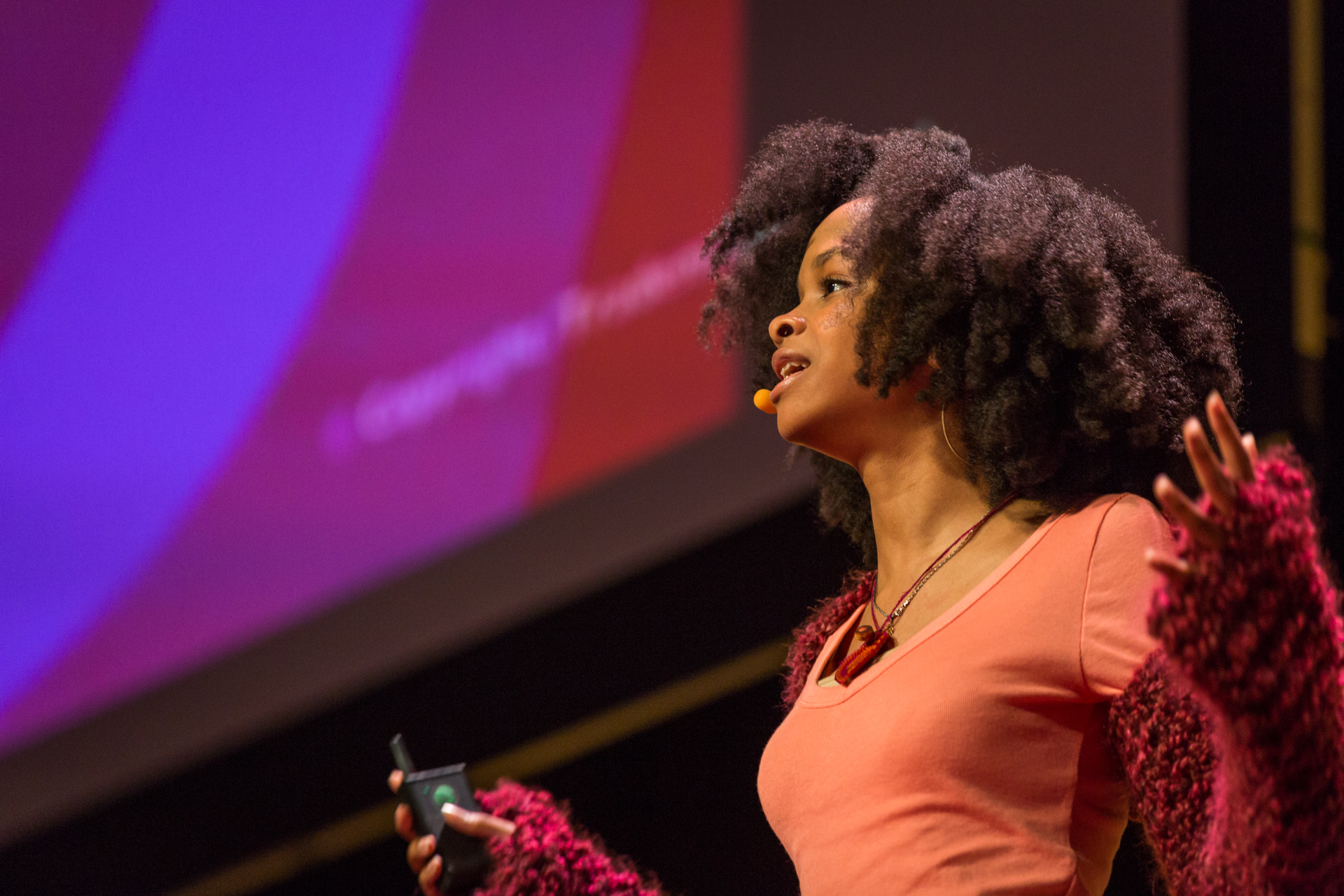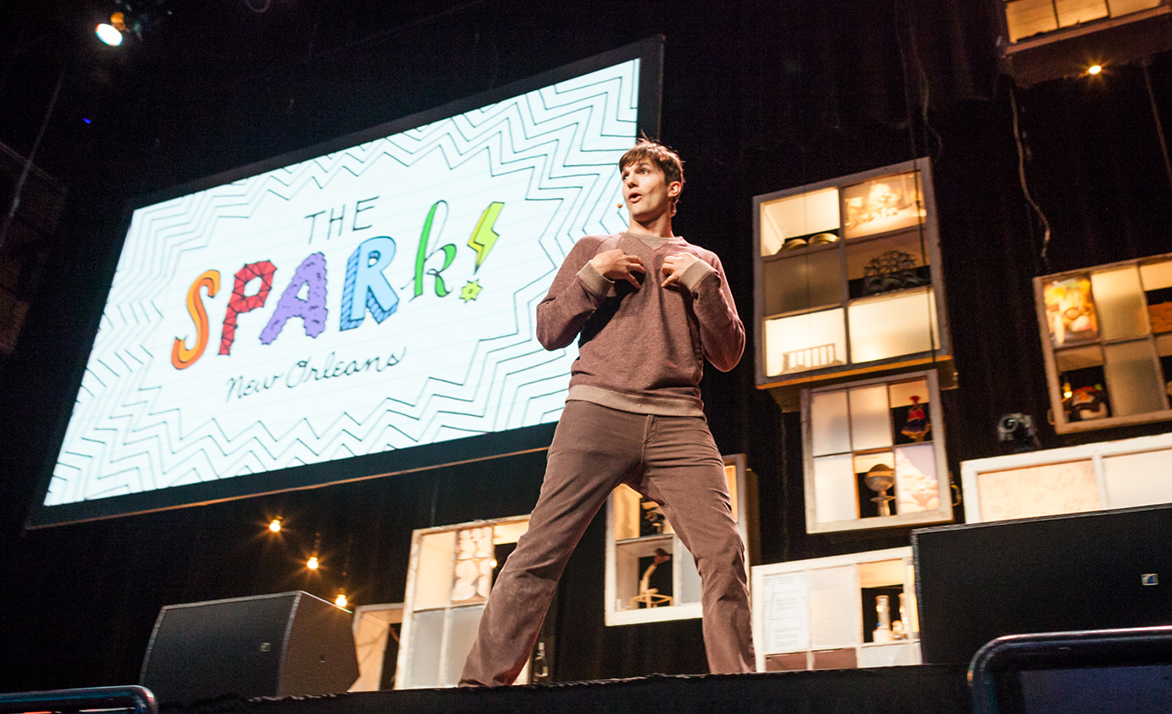By Thu-Huong Ha and Kate Torgovnick
The morning session of TEDYouth “The Spark” was incredible. But in many ways it was just an appetizer. In the afternoon, Sessions 2 and 3 delivered talks on topics ranging from how to make an Easy Bake Oven gender-neutral to the mathematics of Pixar animation to the familial structures of elephants. And it all ended with a surprise appearance from Ashton Kutcher, talking about his “magnificent” failures, and what he learned from each one. Here, a recap of the two sessions.
A grand tradition at TEDYouth — seriously slammin’ spoken word performances. Here to continue it: Justin Lamb, performing his poem “Sweaty Teacher.” The basic idea, in two lines: “I’d love to be the compassionate teacher, the tough-but-fair teacher. … But it’s no use, because I am the sweaty teacher.”
Maya Penn is an entrepreneur who makes eco-friendly fashion, and who had the chops to build and maintain her retail website. Did we mention that she is also 13 years old? Here at TEDYouth, Penn shares why she decided to open a shop in the first place — because people always commented on her creations — and why she decided to branch out into animation. “I didn’t have a business plan. I was only 8!” she says, to laughs. Her advice to the crowd? “Do what you love, have fun and just go for it.”
Erika De Benedictis has a bumper sticker on her car that reads, “Honk if you think Pluto is still a planet.” The 20-year-old, who works at NASA’s Jet Propulsion Laboratory and who, two years ago, created software to make space travel more fuel-efficient, explains why Pluto was downgraded from planet status in 2006. And she reminds us that the solar system is deeply complicated. “There aren’t eight objects,” she says, referring to the now-eight planets we all know by heart. “There are millions of objects, and each one’s gravity affects the movement of all the other objects.”
Why chase dreams when you can chase storms? Based at the Center for Severe Weather Research in Boulder, Karen Kosiba is an atmospheric scientist who studies how tornadoes form and do damage. (Did you know we still actually aren’t sure how they begin? Huh!) Trouble is, most prolific tornado producers, so-called “supercell thunderstorms,” may well not amount to much. What really matters is how a storm acts at the building level, and just because those ones rotate high in the air doesn’t mean they rotate nearer the ground. (Another problem? It’s hard to get near the damn things; apparently most people aren’t too keen on driving right into tornadoes. Weird.) But through observations and modeling, Kosiba was able to catch a rare data set, a tornado her team tracked throughout its entire lifespan: from before it formed, throughout its duration and even after it dissipated.
When McKenna Pope was 13 (she’s now an ancient 14) she was pretty psyched that her four-year-old-brother’s favorite thing to do was cook. But when he decided “Only girls cook,” she was distressed. Then she noticed that Hasbro’s Easy-Bake Oven, a toy her brother had previously been dying for, only came in pink and purple, and only featured girls in its commercials. So she did what any 13-year-old would do: She uploaded her complaint as a YouTube video and petitioned the CEO of Hasbro to change the company’s marketing strategy to be more gender-neutral. Here’s the kicker: It worked. In a matter of weeks Pope got 46,000 signatures, and she was invited to the Hasbro headquarters to see the unveiling of a brand new product. Says Pope to the theater, filled with teenagers: “I realized that my voice mattered, and your voice matters too.”
Bivian “Sonny” Lee has a powerful request: Every time you hear or use the “n-word,” replace it with the word “slave.” Then see how you feel about saying it. Because, says Lee, head of the Son of a Saint Foundation, they’re essentially synonymous. In a sobering talk, he makes the case that the n-word should never be uttered again. The word is simply too hateful, not to mention entirely disrespectful to the generations of enslaved and then segregated black men, women and children in the US for whom the word was a terrible slur. As for the defense put up by rappers and the like that by using the word over and over, they’re “owning it.” Not so, says Lee.
Can pop culture be used to feed social awareness? Absolutely, says New Orleans’ own Brandon Odums, who transformed walls in the 9th Ward with his murals of civil rights leaders. “8,300 students drop out of school every day,” says Odums, also the founder of 2-Cent Entertainment. “If a business lost 8,300 customers every day, it would be a state of emergency.” Odums has a strong message for the crowd: people are listening on social media; use it to create real change.
Tony DeRose is a Senior Scientist at Pixar Animation Studios, which means, naturally, he spends all day thinking about math. Hm? What’s that you say? DeRose is here at TEDYouth to demonstrate that what you learn in middle and high school math class is used all the time in animation. When Toy Story‘s Woody moves across the screen, gets bigger and smaller or rotates, that’s a combination of coordinate geometry and trigonometry. DeRose also introduces “sub-division surfaces,” which creates smooth curves. Turns out, most Pixar characters, including Ariel from The Little Mermaid, are made up of sub-division surfaces.

Cynthia Bir looks at how math and science make a difference on the basketball court. Photo: Ryan Lash
Cynthia Bir, a biomedical engineer at the University of Southern California and one of the minds behind the ESPN TV show Sport Science, wants us to think about the physics of basketball. “Basketball players, baseball players, football players — they all rely on trajectories for their shots,” she explains. Bir walks us through the factors that determine whether a basketball player gets a swish of the net or the crowd yelling “airball”: launch angle; velocity and range.
Science blogger Rhett Allain is the author of Angry Birds Furious Forces and an associate professor of physics at Southeastern Louisiana University. (Yes, his book uses the game Angry Birds to demonstrate basic physics concepts.) Today Allain is at TEDYouth to talk about models. Models are important to figure out how, physically and mathematically, things are supposed to work. Important examples: Helicopter rotors, comets and… people trapped in rooms with zombies?? (Hint: If you just keep running around in a circle, the zombie will never catch you.)
Caitlin O’Connell-Rodwell spends a lot of time with elephants, studying the ways they communicate and form family bonds. Her conclusion after 20 years of research — they are a lot like us. A professor at the Stanford School of Medicine in California, O’Connell-Rodwell describes elephant family reunions, and how male elephants strike out on their own between the ages of 13 to 15. (Sound vaguely familiar? Yes.) She looks at how the character of an elephant family is influenced by its matriarch, and gives us an understanding of the hugely varied elephant personalities, all while showing amazing photographs of the animals in action.
Clayton Cameron — aka the “Brush Master” — is a renowned drummer and brush player who bends genres — jazz, funk, hip hop, pop, R&B, Latin, you name it. On stage today he has one drum, two brushes, and… math. He likes to think of the marriage between rhythm and arithmetic as “a-rhythm-e-tic.” A dollar can be divided into four quarters, and so can a 4/4 measure. For six minutes Cameron doesn’t stop the beat — or the brushing — or the ballerness. Watch his performance from TEDxManhattanBeach »
Sicily Kolbek is building a tiny house. No, not a dollhouse. A miniature house that a person could actually live in. With the help of her parents, this 13-year-old has created “La Petite Maison,” a 128-square-foot abode. In this talk, she shares where the idea for the project came from and how she almost gave up when her father was killed in a car accident. But, she says, he was always inspired to think about what came next, and now that the house is done she’s inspired to think similarly.
Jonathan Mannion has photographed most of the big names in hip hop and R&B from the past 15 years. He was on stage with Biggie, he bonded with Aaliyah, he shot eight album covers for Jay-Z, he hung out with Drake and his grandmother and he notably persuaded DMX it was totally cool to dive on into a pool of blood. Yet he’s not just here to namedrop. The most important parts of his work, he says, are capturing a moment, connecting with a subject and not taking a photo, but giving it.
“Science is a rough draft,” says Henry Lin. “There is so much that still baffles us and challenges our understanding.” This Harvard student, who hails from Shreveport, Louisiana, won this year’s Intel Science Fair for his models of galaxy clusters. On the TEDYouth stage, he shares why he is researching these clusters, which are very big, very hot and very strange: “We can learn a lot about the universe by tracking its largest pieces.”
Eddy Cartaya is a law enforcement officer at Deschutes National Forest in Oregon. He’s also a cave explorer. Through beautiful vivid photos he tells the story of the Mount Hood region near Portland, Oregon, where he and photographer Brent McGregor discovered and explored a series of previously unexplored caves. In fact, they were a rare type of cave, made of glacier instead of solid rock. That means two things: each year, entirely new tunnels form, and every day the whole cave is moving. With their survey tools, Cartaya and McGregor were able to make a 3D map of the Mount Hood caves. But really, anyone can be an explorer, concludes Cartaya. All you have to do is, “look and go where people don’t often go.”
Surprise guest Ashton Kutcher comes clean at TEDYouth: he didn’t like school. And while he once studied to be a biochemical engineer, he declares that his greatest learnings in life came from failures rather than teachers. “I am a magnificent failure,” he says, going on to share three big lessons that came from crashing and burning. First, he shares the tale of getting caught breaking into his high school. Lesson learned: Own up to your mistakes. Next, he reveals feeling that he had failed his moral upbringing when a former girlfriend got an abortion. Lesson learned: “Your morals evolve based on life experiences. As you evolve through experience, you create your beliefs.” Finally, he tells the story of deciding to end his engineering education and try life as a model. Lesson learned: you have to take risky chances to find your purpose. And that finding your purpose, actually, is not a one-time thing, but a constant in life.
And… that’s a wrap. Our thanks to all the speakers, impeccable hosts Kelly Stoetzel and Rives, the entire TED crew on the ground, the incredible, energetic audience and all those hosting TEDxYouth events or tuning in to watch the livestream. Hope you enjoyed it. See you next year!


Comments (10)
Pingback: TED-Ed Blog» Blog Archive TED-Ed at TEDYouth 2013 «
Pingback: Maya Shea Penn Shares Stage with Ashton Kucher at Ted Youth | The Pollination ProjectThe Pollination Project